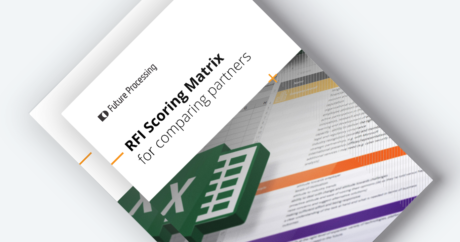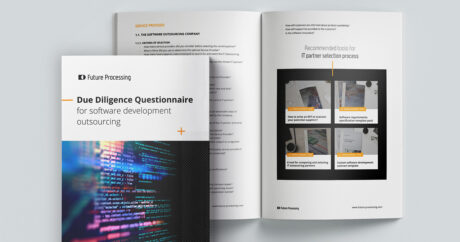Begin your search for the perfect Managed Services Provider effortlessly using our free RFP template! Designed to simplify your selection process, this comprehensive template covers all essential aspects, ensuring you don’t miss any critical details.
How to write an RFP and what should it include?
In all business sectors, a request for proposal (RFP) is a document that gives prospective vendors all the specific information necessary to develop a technological solution, based on the actual requirements. Drafting a successful request for proposal is challenging, but if you do it right, you can ensure your tech solutions are in expert hands.
The essential elements of an RFP are:
- Project Information
- Supplier Questionnaire
The project information is is where you tell your potential software development company who you are and what your area of expertise is, determine a rough scope of the project to be done and assess the timeline and budget available.
The supplier questionnaire section gathers information from the potential suppliers. Normally, it includes numerous questions and topics, but the best RFPs also feature “knockout” questions. Their goal is to filter out prospective vendors purely on the basis of their responses to those questions. Also, the questionnaire should support a weight-scoring mechanism to make the comparison of the proposals easier.
Essential elements of a successful RFP for Managed Services.
When drafting a Managed Services Request for Proposal (RFP), it’s crucial to include several key elements to ensure you attract the right providers and get the most comprehensive solutions for your needs. Here’s a summary of what to focus on:
- Company Overview and Project Objectives: Provide a brief introduction to your company and outline the problem statement or specific goals you aim to achieve through managed services.
- Scope of IT Services: Clearly define the range of services needed, including specific tasks, technologies involved, and a clear, in-depth analysis of your specific IT requirements, including both current needs and future projections.
- Service Level Agreements (SLAs): Detail the expected performance standards, availability, response times, and resolution timelines.
- Compliance and Security Requirements: Specify any regulatory compliance needs and security protocols that the provider must adhere to.
- Budget and Pricing Information: Include your budget constraints and preferred pricing model.
- Evaluation Criteria: Define clear criteria for evaluating proposals, such as experience, technical capabilities, pricing, customer service, and compliance with your requirements. you may also want to assess how well the MSP’s culture and approach align with your company’s values and working style.
- Vendor Qualifications and Experience: Outline the qualifications and experience you’re looking for in a provider, including industry expertise and references.
- Proposal Submission Guidelines: Provide clear instructions on how proposals should be structured, submission deadlines, and contact information for queries.
Including these elements will ensure your RFP is comprehensive and tailored to attract providers that can best meet and address your business’s managed services needs.
Read more about Managed Services:
- What Are Managed IT Services? Definition and Types
- Dedicated Team vs Managed Services: Comparison
- Managed Services vs. Staff Augmentation: Key Differences
- The Importance of Managed IT Services: how it will change your business?
- The 9 benefits of Managed IT Services
Avoiding common pitfalls in Managed Services Proposal
When drafting a Managed Services Proposal, it’s crucial to sidestep common pitfalls to ensure a fruitful collaboration. Key among these is avoiding ambiguity in service descriptions, which can lead to misunderstandings about deliverables. It’s essential to be precise about the scope and limitations of offered services.
Another trap is underestimating the importance of a flexible service model that can adapt to evolving business needs. Additionally, overlooking the integration of new services with existing systems can disrupt operational flow.
A well-crafted proposal should also emphasize strong communication channels to facilitate seamless interactions with customers and swift issue resolution. Lastly, neglecting to outline a clear strategy for measuring service effectiveness can impede the ability to evaluate the partnership’s success and make necessary adjustments. Addressing these areas in your proposal will pave the way for a more effective and harmonious MSP partnership.
Post-submission processes: what happens after the RFP for Managed Services is submitted?
When the RFP is done, you need to evaluate the proposals (have a look at our Tool for comparing and selecting IT outsourcing partners), select a vendor, check their references, negotiate and sign contracts. It’s important to notify the vendors that did not make it – any feedback you can give them will serve them in their future endeavours.
During the post-submission phase, it’s essential to follow a structured and transparent process to make informed decisions, maintain vendor relationships, and mitigate risks. Effective communication and collaboration among all stakeholders are critical to the success of the project.
Transforming IT Operations: The Impact of a Well-Crafted RFP
In the realm of IT operations, the power of a well-crafted RFP cannot be overstated. This crucial document serves as a cornerstone in transforming IT infrastructure and services, acting as a bridge between business’s needs and the solutions offered by potential service providers.
A comprehensive RFP process enables businesses to evaluate and compare potential providers on a uniform basis, ensuring a transparent and objective selection process. A well-structured RFP is a strategic tool that can significantly enhance the quality of IT services or recommended solution, directly impacting the efficiency, scalability, and innovation within an organization’s IT operations.
The needs of each organisation vary and therefore the RFP for Managed Services should be tailred to your needs.
With the benefit of our experience and tailored approach, we can help you create a partnership and solution that drives your business forward.
Download our template, adjust it to your project and get an irreplaceable, high quality tool in a decision-making process.
And if you’re looking for an IT company, look at our materials:


